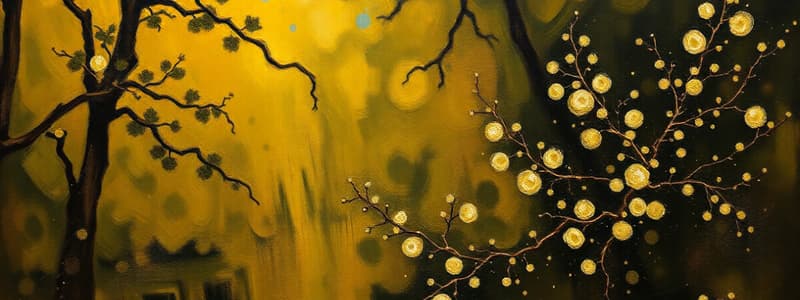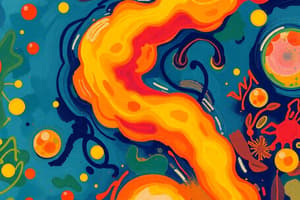Podcast
Questions and Answers
What color change is expected when iodine is added to the starch solution?
What color change is expected when iodine is added to the starch solution?
- Yellow
- Blue-black (correct)
- Red
- Colorless
What role does NaCl play in the iodine test with glycogen?
What role does NaCl play in the iodine test with glycogen?
- It dilutes the sample
- It breaks down the glycogen
- It enhances color reaction (correct)
- It neutralizes the iodine
Which of the following is a feature of salivary amylase in starch hydrolysis?
Which of the following is a feature of salivary amylase in starch hydrolysis?
- It requires high temperatures to function
- It chemically alters starch structure completely
- It is a catalyst that slows down reactions
- It breaks starch into maltose and dextrin (correct)
What happens when starch is mixed with 10% NaOH in Tube 2B?
What happens when starch is mixed with 10% NaOH in Tube 2B?
Which result should be observed in test tube 1 that contains only water during the iodine test?
Which result should be observed in test tube 1 that contains only water during the iodine test?
What is the main mechanism through which salivary amylase acts on starch?
What is the main mechanism through which salivary amylase acts on starch?
How does the presence of amylose versus amylopectin influence iodine's color reaction?
How does the presence of amylose versus amylopectin influence iodine's color reaction?
What occurs during the hydrolysis of starch when the iodine reaction indicates a decrease in starch presence?
What occurs during the hydrolysis of starch when the iodine reaction indicates a decrease in starch presence?
What is the color of the complex formed when starch reacts with iodine?
What is the color of the complex formed when starch reacts with iodine?
Which polysaccharide gives a pale reddish brown color when treated with iodine?
Which polysaccharide gives a pale reddish brown color when treated with iodine?
What effect does excessive heating have on the amylose-iodine complex?
What effect does excessive heating have on the amylose-iodine complex?
Which solution pH is necessary for optimal interaction between starch and iodine?
Which solution pH is necessary for optimal interaction between starch and iodine?
What is the result of adding sodium thiosulfate to the iodine-starch complex?
What is the result of adding sodium thiosulfate to the iodine-starch complex?
Which type of polysaccharide does dextrin resemble in terms of iodine reaction color?
Which type of polysaccharide does dextrin resemble in terms of iodine reaction color?
What role does salivary amylase play in the reaction with starch?
What role does salivary amylase play in the reaction with starch?
Which of the following statements is true regarding the helical structure of amylose?
Which of the following statements is true regarding the helical structure of amylose?
Which structural feature distinguishes amylopectin from amylose?
Which structural feature distinguishes amylopectin from amylose?
What is the optimal pH range for the activity of α-amylase in hydrolyzing starch?
What is the optimal pH range for the activity of α-amylase in hydrolyzing starch?
What type of polysaccharide is primarily found in animal cells?
What type of polysaccharide is primarily found in animal cells?
Which bond types can α-amylase hydrolyze?
Which bond types can α-amylase hydrolyze?
What forms when iodine interacts with amylose in a neutral solution?
What forms when iodine interacts with amylose in a neutral solution?
How does β-amylase differ from α-amylase in its function?
How does β-amylase differ from α-amylase in its function?
Why is hydration important for the digestion of starch?
Why is hydration important for the digestion of starch?
What type of bonds connect the glucose units in branched regions of glycogen?
What type of bonds connect the glucose units in branched regions of glycogen?
Flashcards are hidden until you start studying
Study Notes
Starch Isolation and Hydrolysis
- Starch is a plant storage polysaccharide composed of amylose and amylopectin.
- Amylose is a linear chain of glucose units linked by α(1→4) glycosidic bonds.
- Amylopectin has α(1→4) linkages and branches every 24 to 30 residues, formed by α(1→6) glycosidic bonds.
- Glycogen is an animal storage polysaccharide structurally similar to amylopectin but with more frequent branches (every 8 to 12 residues).
- α-Amylase, found in saliva and pancreatic juice, hydrolyzes internal α(1→4) bonds in starch and glycogen.
- Produces maltose, maltotriose, and α-limit dextrins (average 8 glucose units with α(1→6) bonds).
- Cannot break α(1→6) bonds or α(1→4) bonds at branch points.
- β-Amylase, found in plants, removes maltose units from the non-reducing end of starch.
- An exoenzyme that produces β-maltose and β-limit dextrins.
- Cannot pass α(1→6) branch points.
- Iodine forms complexes with starch, amylopectin, glycogen, and dextrins.
- Starch forms an intense blue complex due to the interaction of iodine with amylose's helical structure.
- Amylopectin and glycogen form less intense reddish-brown complexes due to their branched structures.
- Dextrin forms a pale color similar to glycogen.
- Maltose and glucose do not form complexes with iodine.
- NaCl addition intensifies the color reaction with glycogen and dextrin due to its role in α-amylase activity.
- Factors affecting the iodine-starch reaction:
- Excessive heating denatures amylose's helical structure, reducing the blue color.
- Extreme acidity or alkalinity reduces the interaction between iodine and starch.
- Sodium thiosulfate reacts with iodine, causing the blue-black color to disappear.
Starch Isolation Procedure
- Potato is ground and strained through cheesecloth to obtain a suspension of starch granules.
- The starch suspension is washed repeatedly with water to remove impurities.
- The washed starch is suspended in water and boiled to dissolve it.
Iodine Test
- Water (negative control), starch solution, and glycogen solution are tested with iodine.
- Starch solution forms a blue-black color, while glycogen solution forms a pale reddish-brown color.
- NaCl intensifies the color reaction with glycogen.
- Heating, adding NaOH, or adding thiosulfate solution alters the iodine reaction based on the factors mentioned above.
Starch Hydrolysis by Salivary Amylase
- Salivary amylase hydrolyzes starch, and the products can be tracked using iodine and Benedict's reagent.
- Iodine reaction provides information about starch degradation, with different colors indicating the presence of various starch products.
- Benedict's reagent detects the presence of reducing sugars produced during starch breakdown.
Studying That Suits You
Use AI to generate personalized quizzes and flashcards to suit your learning preferences.




